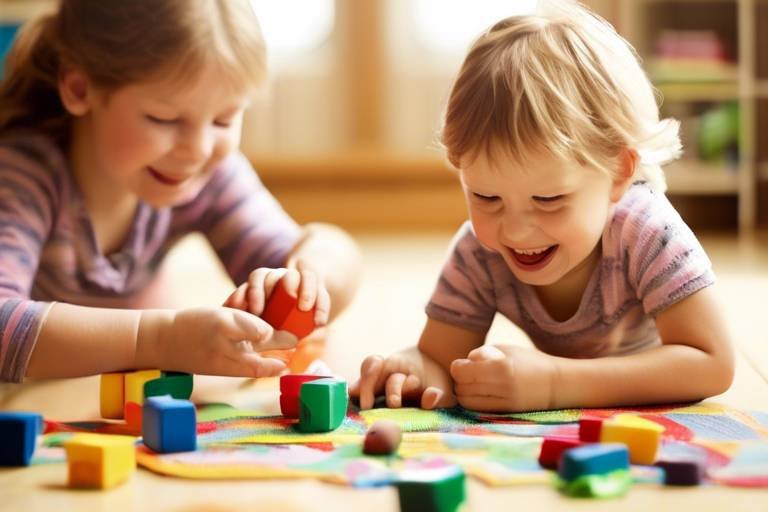Tips For Helping Your Child Overcome Shyness
Shyness can feel like a heavy cloak that children sometimes wear, making them hesitant to step into the world around them. As parents and caregivers, it’s essential to recognize that shyness is not just a phase; it can significantly impact a child's social interactions and emotional development. The good news is that with the right strategies, you can help your child shed this cloak and embrace their social side with confidence. In this article, we will explore effective tips and techniques to assist your child in overcoming shyness, fostering their self-esteem, and enhancing their social skills for better interactions with peers and adults.
Understanding the roots of shyness is the first step in addressing it. Shyness can stem from various factors, including temperament, past experiences, or even environmental influences. Children who are naturally more reserved may find themselves feeling anxious in new social situations, leading to avoidance behaviors. Symptoms of shyness can manifest in different ways, such as reluctance to speak, avoiding eye contact, or clinging to a parent in social settings. Recognizing these signs is crucial, as they can hinder a child’s ability to form friendships and engage meaningfully with others. It's important to remember that shyness is not a flaw; rather, it’s a trait that many children possess, and with patience and support, they can learn to navigate their social world more comfortably.
One of the most effective ways to help your child overcome shyness is by encouraging social interaction. Creating opportunities for your child to engage with peers in a comfortable environment can significantly enhance their social skills. Think of it as providing them with a safe playground where they can practice their social muscles without the fear of judgment. Start small by arranging low-pressure situations, such as inviting a friend over for a casual playdate or participating in group activities. It's essential to ensure that these interactions are enjoyable and not forced, as this can lead to increased anxiety rather than alleviating it.
Organizing playdates or group activities can be a fantastic way to promote socialization among children. Structured play allows children to engage in fun activities while naturally developing their communication skills. For instance, consider setting up a themed playdate where children can participate in games or crafts that require teamwork. This not only makes the experience enjoyable but also encourages children to work together, fostering friendships in the process. Remember, the key is to create an atmosphere where your child feels safe and supported, allowing them to express themselves freely.
Choosing a familiar and comfortable setting for playdates can work wonders in easing your child's anxiety. Think of it as creating a cozy nest where they can feel secure. Whether it’s hosting a playdate at your home or visiting a favorite park, the right environment can significantly impact how your child interacts with others. A relaxed setting can help reduce the pressure they might feel in more formal or unfamiliar situations, allowing them to engage more openly with their peers.
Facilitating guided group activities can provide structure and help shy children engage more confidently. Activities like team sports, group art projects, or even simple games can serve as icebreakers, making it easier for children to connect. By participating in organized games, children learn to communicate, cooperate, and build camaraderie with their peers. It's essential to ensure that these activities are inclusive, so everyone feels like a valued participant, thus encouraging shy children to take part without fear.
Fostering self-esteem is essential in helping your child overcome shyness. Children who feel good about themselves are more likely to take social risks and engage with others. You can boost your child's self-confidence through simple yet powerful techniques, such as offering praise for their efforts, encouraging them to try new things, and providing positive reinforcement. Celebrate their small victories, whether it’s speaking up in class or making a new friend at school. By creating a supportive environment where your child feels valued and appreciated, you pave the way for them to blossom socially.
Children often learn by observing the adults in their lives. This is why it’s crucial for parents and caregivers to model positive social behaviors. Demonstrating how to initiate conversations, express feelings, and handle social situations can provide a framework for children to emulate. Think of yourself as a coach, guiding them through the plays of social interaction. Your actions speak volumes, so make sure to showcase kindness, empathy, and effective communication in your daily interactions.
Demonstrating how to initiate and maintain conversations can be incredibly beneficial for children. You can practice this at home by role-playing different social scenarios. For example, you might say, “Let’s pretend we’re meeting someone new at a party. How would you introduce yourself?” This kind of interactive practice can help your child feel more prepared and confident when faced with real-life social situations.
Teaching children how to handle various social situations prepares them for real-life interactions. Discuss common scenarios they might encounter, like joining a new group or dealing with disagreements among friends. Encourage them to express their feelings and thoughts openly and provide them with strategies to navigate these situations. By equipping your child with the tools they need to handle social challenges, you empower them to face the world with confidence.
Q: How can I tell if my child is shy or just introverted?
A: Shyness often involves anxiety in social situations, while introversion is more about personal preference for solitude. Pay attention to how your child reacts in social settings; if they seem anxious or withdrawn, they may be shy.
Q: What if my child doesn't want to participate in social activities?
A: It's important to respect your child's feelings. Encourage them gently and offer choices that align with their interests. Sometimes, starting with smaller groups or familiar faces can help ease them into social activities.
Q: Can shyness be outgrown?
A: Many children do outgrow shyness as they gain more social experience and confidence. However, consistent support and encouragement from parents can help facilitate this growth.

Understanding Shyness
Shyness is more than just a fleeting feeling; it’s a complex emotional state that can deeply influence a child's social interactions and overall development. Understanding shyness is crucial for parents and caregivers who want to help their children navigate social landscapes with confidence. At its core, shyness often stems from a mix of personality traits and environmental factors. Some children are naturally more reserved, while others may become shy due to past experiences, such as negative social interactions or a lack of exposure to group settings.
Identifying the symptoms of shyness can be the first step in addressing it effectively. Signs may include:
- Avoidance of eye contact
- Physical withdrawal from social situations
- Difficulty in initiating conversations
- Expressing anxiety before social events
These behaviors can significantly hinder a child's ability to form friendships and express themselves, leading to feelings of isolation and frustration. It’s essential to recognize that shyness is not simply a phase that children will outgrow; it can manifest into more profound issues if left unaddressed. For instance, a shy child may struggle with low self-esteem, which can affect their academic performance and emotional well-being.
Moreover, the impact of shyness extends beyond the individual child. It can influence family dynamics and relationships with peers. Parents might notice their shy child being left out during playtime or not being invited to birthday parties, which can create a cycle of loneliness. Understanding these patterns can help parents take proactive steps to foster a more inclusive and supportive environment.
To effectively combat shyness, it’s important to create a nurturing atmosphere where children feel safe to express themselves. Encouraging gradual exposure to social situations, celebrating small victories, and reinforcing positive behaviors can make a significant difference. In essence, understanding the roots and ramifications of shyness allows parents to tailor their approach, ensuring their children have the tools they need to thrive socially.

Encouraging Social Interaction
Encouraging your child to engage in social interactions is one of the most effective ways to help them overcome shyness. Think of social skills like a muscle; the more you use them, the stronger they become. By providing your child with opportunities to interact with their peers, you help them practice and refine these essential skills in a safe and supportive environment. It’s all about creating moments where they can shine, feel confident, and, most importantly, have fun!
One of the best ways to promote social interaction is through playdates and group activities. These settings allow children to connect with others while participating in fun and engaging activities. When planning these interactions, consider the interests of your child and their friends. For example, if your child loves art, organizing a painting party could be a fantastic way for them to bond with others. The key is to create a relaxed atmosphere where everyone feels comfortable expressing themselves.
When you organize playdates or group activities, you provide a structured yet fun environment for your child to socialize. Think of it as setting the stage for a play; the right backdrop can make all the difference. Here are some ideas to consider:
- Outdoor Games: Activities like tag or hide and seek can help children interact naturally while having a blast.
- Craft Projects: Collaborative art projects can encourage teamwork and communication among kids.
- Board Games: These not only promote social interaction but also teach children about taking turns and following rules.
Selecting a familiar and comfortable setting for playdates can significantly ease your child's anxiety. Imagine being dropped into a foreign land without a map; it can be daunting! A familiar environment, like your home or a friend's house, can make all the difference. It’s essential to create a space where your child feels safe and secure, allowing them to open up more easily. Consider decorating the space with their favorite toys or games to make it feel inviting and personal.
Facilitating guided group activities can provide the necessary structure for shy children to engage more confidently. Think of these activities as a roadmap; they guide children through social interactions while keeping things organized. Activities like team-building games or group challenges can be incredibly beneficial. They not only promote teamwork but also help children learn how to communicate and collaborate effectively. For instance, organizing a small scavenger hunt can encourage children to work together, share ideas, and support one another, ultimately reducing feelings of isolation.
In conclusion, encouraging social interaction is a vital step in helping your child overcome shyness. By creating opportunities for them to connect with others, you enable them to build friendships and develop essential social skills. Remember, it’s all about making these experiences enjoyable and stress-free. The more they practice, the more confident they will become!
Q: How can I help my child if they are nervous about social interactions?
A: Start small by arranging one-on-one playdates with familiar friends. Gradually introduce larger groups as they become more comfortable.
Q: What if my child prefers to play alone?
A: Encourage solo playtime but gently introduce them to group activities. Highlight the benefits of socialization, like making new friends.
Q: Are there specific games that help with social skills?
A: Yes! Games that involve teamwork, such as relay races or cooperative board games, can greatly enhance social interaction and communication.

Playdates and Group Activities
Organizing playdates and group activities is one of the most effective ways to help your child overcome shyness. When children are given the chance to interact with their peers in a relaxed setting, they can practice their social skills and build confidence without the pressure of formal situations. Think of it as planting seeds in a garden; with the right environment, those seeds can grow into strong, vibrant plants. Similarly, by providing opportunities for social interaction, you allow your child to blossom into a more confident individual.
Structured play is particularly beneficial because it creates a framework within which children can engage with one another. For instance, activities like team sports, art projects, or even simple games can encourage cooperation and communication. When children are focused on a common goal, such as winning a game or completing a craft, they often forget their shyness and become more willing to express themselves. This is not just about having fun; it’s about learning to navigate social dynamics in a low-pressure environment.
Moreover, group activities can help children forge friendships that might not develop in one-on-one scenarios. When kids are in larger groups, they can find others with similar interests or personalities, which can lead to meaningful connections. You might be surprised at how quickly shy children can open up when they discover a shared passion with their peers. This is where the magic happens—through shared experiences, they learn that they are not alone in their feelings, and that connection can be incredibly empowering.
However, it’s essential to consider the setting for these playdates. Choosing a familiar and comfortable environment can significantly ease your child’s anxiety. A backyard barbecue, a local park, or even your living room can provide the comfort of home, allowing your child to feel secure. The familiarity of the surroundings can act as a safety net, encouraging them to engage more freely with their friends. Remember, the goal is to create a space where they can express themselves without fear of judgment.
To further enhance these experiences, consider facilitating guided group activities. Structured games or team tasks can provide a sense of direction and purpose, making it easier for shy children to participate. For example, organizing a scavenger hunt can promote teamwork and communication, as children must work together to solve clues and complete challenges. This not only helps them to interact but also builds essential skills like problem-solving and cooperation. It’s a win-win situation!
In summary, playdates and group activities are powerful tools in helping children overcome shyness. By creating opportunities for structured play in familiar settings, you can foster connections and boost your child's self-confidence. So, get ready to roll up your sleeves and organize some fun activities that will not only entertain but also empower your child to shine in social situations!
- What age is appropriate for playdates? Playdates can begin as early as preschool age, typically around 3-4 years old, when children start to develop social skills.
- How can I help my child if they are nervous about a playdate? Talk to them about their feelings, reassure them it’s okay to feel nervous, and encourage them to express their thoughts.
- What activities are best for shy children? Activities that involve teamwork, such as arts and crafts, board games, or outdoor sports, can help shy children engage more comfortably.

Choosing the Right Setting
When it comes to helping your child overcome shyness, the environment in which they interact plays a pivotal role. Imagine walking into a room filled with strangers; it’s easy to feel overwhelmed, right? Now, consider how much more at ease you’d feel in a cozy café with familiar faces. The same principle applies to children. Selecting a familiar and comfortable setting for playdates or social gatherings can significantly reduce anxiety and create a safe space for interaction.
Think about the places your child feels most at home. Is it their backyard, a favorite park, or perhaps a friend's house? These locations often evoke a sense of security, allowing your child to relax and be themselves. When they feel comfortable, they are more likely to engage openly with their peers, making the experience enjoyable rather than daunting.
Additionally, consider the following factors when choosing the right setting:
- Familiarity: A location your child knows well can ease their nerves. They’re already accustomed to the surroundings, which helps them focus on socializing rather than feeling anxious about being in an unfamiliar place.
- Size of the Group: Smaller groups often feel less intimidating. Start with one or two friends rather than a large crowd. This gradual exposure can help build confidence.
- Noise Level: A quieter environment can help your child feel less overwhelmed. Loud, bustling places might be exciting for some, but for a shy child, they can be daunting.
As you set the stage for these interactions, remember that the goal is to create an atmosphere where your child feels empowered to express themselves. Pay attention to their reactions and preferences; if they seem uncomfortable, be ready to adapt. Sometimes, a simple change, like moving the playdate indoors on a rainy day or switching to a quieter park, can make all the difference.
Ultimately, the right setting can transform a potentially stressful experience into a delightful one. By fostering an environment that encourages comfort and security, you’re laying the groundwork for your child to develop essential social skills. It’s like planting a seed in the right soil; with the right conditions, it will flourish!

Guided Group Activities
Engaging children in is an excellent way to help them overcome shyness while simultaneously developing their social skills. These activities provide a structured environment where children can interact with their peers in a less intimidating setting. Imagine a bustling playground filled with laughter and chatter; now think of how that same energy can be channeled into organized games and collaborative tasks. By participating in guided group activities, children can learn to communicate, cooperate, and build friendships without the pressure of spontaneous interactions.
One effective approach is to organize activities that require teamwork. For instance, team sports like soccer or basketball not only promote physical fitness but also encourage children to work together towards a common goal. In these scenarios, children can practice sharing, taking turns, and supporting each other, which are essential skills for building confidence. Additionally, structured activities such as arts and crafts projects can foster creativity while allowing children to express themselves in a group setting. Think of it as a canvas where every child adds their unique touch, creating a masterpiece of collaboration.
Furthermore, it’s important to choose activities that align with the interests of the children involved. When kids are excited about what they’re doing, they’re more likely to participate actively. For example, if a child loves animals, organizing a group trip to a petting zoo or an animal shelter can spark joy and encourage interaction with other children who share similar interests. By creating a connection through shared passions, children can break down the walls of shyness more easily.
To ensure that these guided activities are effective, consider the following tips:
- Set Clear Objectives: Clearly define what you want the children to achieve during the activity. Whether it’s improving communication skills or fostering teamwork, having a goal helps focus their efforts.
- Encourage Participation: Actively involve all children in the activities, ensuring that everyone has a role to play. This inclusion helps shy children feel valued and important.
- Provide Positive Feedback: Celebrate small successes and encourage children with positive reinforcement. A simple “Great job!” can go a long way in boosting their confidence.
As you plan these guided group activities, remember that the key is to create a fun and supportive atmosphere. By doing so, you not only help children practice their social skills but also create lasting memories that can transform their approach to social interactions. Over time, these positive experiences can significantly reduce feelings of shyness, allowing children to blossom into confident individuals ready to face the world.
Q1: What types of guided group activities are best for shy children?
A1: Activities that involve teamwork, such as team sports, arts and crafts, or group games, are particularly effective. These settings provide structure and encourage interaction in a less intimidating environment.
Q2: How can I encourage my child to participate in group activities?
A2: Start by introducing activities that align with your child's interests. Additionally, ensure that the environment is supportive and that all children are encouraged to participate.
Q3: What if my child feels overwhelmed during group activities?
A3: It's important to recognize your child's feelings. Allow them to take breaks if needed and reassure them that it's okay to feel shy. Gradually increasing their exposure to social situations can also help build their confidence.

Building Self-Esteem
This article explores effective strategies and insights to assist children in overcoming shyness, fostering confidence, and enhancing social skills for improved interactions with peers and adults.
Gaining insight into the nature of shyness is crucial. This section discusses its causes, symptoms, and how it can affect a child's social development and emotional well-being.
Promoting opportunities for social interaction can help children practice their skills. This section provides tips on creating environments where children feel comfortable engaging with peers.
Organizing playdates or group activities encourages socialization. Here, we explore how structured play can help children build friendships and reduce feelings of isolation.
Selecting a familiar and comfortable setting for playdates can ease anxiety. This subheading discusses how the right environment can foster positive interactions.
Facilitating guided group activities can provide structure. This section outlines how organized games and team tasks can help shy children engage more confidently.
Fostering self-esteem is essential for overcoming shyness. Think of self-esteem as the foundation of a house; if it's shaky, everything built on top can crumble. Children with low self-esteem often feel inadequate, which can amplify their shyness and lead to a cycle of withdrawal. Therefore, it’s crucial to implement strategies that boost their confidence and self-worth.
One effective technique is to provide consistent praise and encouragement. When children achieve small milestones, such as speaking up in class or making a new friend, acknowledging these accomplishments can significantly impact their self-perception. Instead of generic compliments, try to be specific. For instance, saying, “I’m really proud of how you introduced yourself to your new classmate!” can resonate more deeply than a simple “Good job!”
Additionally, engaging in activities that highlight a child's strengths can also bolster their self-esteem. Whether it's sports, arts, or academics, finding a niche where they excel allows them to shine. Encourage your child to participate in these activities, and celebrate their efforts, regardless of the outcome. Remember, the journey is just as important as the destination!
Another strategy is to help children set realistic goals. When children have clear, achievable objectives, they can experience a sense of accomplishment when they meet them. This could be as simple as initiating a conversation with a peer or participating in a group discussion. Breaking down larger goals into smaller, manageable steps can make the process less daunting. For example:
| Goal | Steps to Achieve |
|---|---|
| Make a new friend |
|
| Speak up in class |
|
Moreover, teaching children about self-acceptance is vital. Encourage them to embrace their unique qualities and understand that everyone has strengths and weaknesses. You can share stories or examples of famous individuals who overcame their own insecurities, illustrating that it’s okay to be different and that everyone has their own journey.
Finally, consider incorporating mindfulness and relaxation techniques into their routine. Activities like deep breathing, meditation, or even yoga can help children manage anxiety and build a more positive self-image. When they learn to calm their minds, they can approach social situations with greater confidence.
Children often learn by observing. This section emphasizes the importance of adults modeling positive social behaviors to provide a framework for children to emulate in their interactions.
Demonstrating how to initiate and maintain conversations can be beneficial. This subheading highlights techniques for effectively modeling communication skills for children.
Teaching children how to handle various social situations prepares them for real-life interactions. Here, we discuss strategies for addressing common challenges they may face.
1. What age does shyness usually develop in children?
Shyness can develop at different stages, but it often appears in early childhood, around the ages of 2 to 4, when children start to engage with peers.
2. How can I tell if my child's shyness is a problem?
If your child's shyness leads to significant distress or hinders their ability to form relationships or participate in activities, it may be time to seek support.
3. Are there professional resources available for shy children?
Yes! Many therapists and counselors specialize in childhood anxiety and social skills training, which can provide additional support for your child.

Modeling Social Behavior
Children are like little sponges, soaking up everything around them, especially from the adults in their lives. When it comes to overcoming shyness, is one of the most effective strategies you can employ. This doesn’t just mean telling your child what to do; it involves showing them through your actions and interactions. Think of it as a dance: if you lead with confidence and grace, your child will likely follow your steps. But what does this look like in practice?
First, it’s essential to create a positive social environment around your child. Show them how to engage in conversations by initiating chats with friends, family, or even strangers in a friendly manner. For instance, when you encounter a neighbor, take a moment to greet them warmly. This simple act demonstrates to your child that social interactions can be pleasant and rewarding. It’s about creating a safe space where they can observe and learn.
Another vital aspect is to demonstrate effective communication skills. This includes not just speaking but also listening. Engage your child in conversations where you practice active listening—nodding, maintaining eye contact, and responding thoughtfully. When they see you engaged and interested, it reinforces the idea that social interactions are a two-way street. You might even consider using role-playing scenarios at home, where you can practice different social situations together. This can be especially useful for preparing your child for school or playdates.
Additionally, it’s important to teach your child how to handle various social situations. For example, if they’re invited to a birthday party, discuss how they might introduce themselves or join a game. You can create a simple table of common social scenarios and potential responses, helping them feel more prepared and less anxious:
| Social Scenario | Suggested Response |
|---|---|
| Meeting a new classmate | "Hi, I'm [Your Child's Name]. What's your name?" |
| Joining a group game | "Can I play too?" |
| Responding to a compliment | "Thank you! I really liked your drawing too!" |
| Asking someone to play | "Do you want to play [game] with me?" |
By practicing these scenarios, your child will gain confidence in their ability to navigate social situations. Remember, the goal is to make these interactions feel natural and enjoyable. The more they see you modeling positive social behavior, the more they will internalize these lessons.
Lastly, don't forget to celebrate small victories. When your child successfully engages in a social interaction, acknowledge their effort. A simple, "I saw you talking to your friend today, and I’m so proud of you!" can work wonders for their self-esteem. This positive reinforcement will encourage them to continue practicing their social skills.
In summary, modeling social behavior is not just about what you say but what you do. By demonstrating positive interactions, practicing communication skills, and preparing your child for various scenarios, you’re providing them with the tools they need to overcome shyness. Remember, patience is key. Change doesn’t happen overnight, but with your guidance, your child can blossom into a confident social butterfly.
- What if my child is still shy despite my efforts?
It's important to remember that every child is different. Continue to provide support and encouragement, and consider seeking advice from a child psychologist if necessary. - How can I encourage my shy child to make friends?
Organize small, low-pressure playdates and encourage your child to participate in group activities where they can meet peers with similar interests. - Are there specific games that can help with social skills?
Games that require teamwork, such as relay races or cooperative board games, can help children practice communication and collaboration. - How do I know if my child's shyness is a concern?
If their shyness significantly impacts their daily life, such as avoiding school or social events, it may be time to consult a professional.

Demonstrating Conversations
One of the most effective ways to help your child overcome shyness is by . Children are like little sponges, soaking up everything they see and hear. When they observe adults engaging in conversations, they learn the nuances of communication—everything from body language to tone of voice. Have you ever noticed how kids mimic their parents? This powerful learning mechanism can be harnessed to teach your child how to initiate and maintain conversations with others.
Start by creating opportunities for conversation in your daily life. For instance, when you’re at the grocery store, engage the cashier in a friendly chat. Your child can see firsthand how easy it is to strike up a conversation. You might say something like, “Hi there! How's your day going?” This simple act not only models behavior but also shows your child that people enjoy talking to one another. It’s important to keep the tone light and engaging; after all, conversations should feel natural, not forced.
Next, consider role-playing different social scenarios with your child. This can be a fun and interactive way to practice. You might set up a mock playdate where you and your child take turns being the host and the guest. Here are some conversation starters you can use during your role play:
- “What’s your favorite game to play?”
- “Have you seen any good movies lately?”
- “What do you like to do during recess?”
By practicing these scenarios, your child can gain confidence in their ability to engage in conversations. It’s like training for a big game; the more you practice, the better you become!
Additionally, encourage your child to ask open-ended questions. These types of questions invite more than just a yes or no answer, prompting deeper discussions. For example, instead of asking, “Did you have fun at the park?” you might guide them to ask, “What was your favorite part of the park?” This not only encourages a more engaging conversation but also teaches your child how to keep the dialogue flowing. Remember, conversations are a two-way street, and learning to ask questions is just as important as learning to answer them.
Finally, be patient and supportive. Celebrate small victories—like when your child initiates a conversation or engages with a peer. Reinforcing their efforts with praise can significantly boost their confidence. You might say, “I noticed how you talked to your friend today! That was amazing!” This positive reinforcement helps them associate social interactions with good feelings, making them more likely to engage in the future.
In conclusion, demonstrating conversations is a powerful tool in helping your child overcome shyness. By modeling behavior, practicing through role-play, encouraging open-ended questions, and providing positive reinforcement, you can equip your child with the skills they need to thrive socially. Remember, every little step counts, and with your support, your child can blossom into a confident communicator!
Q: How can I tell if my child is shy or just introverted?
A: Shyness often manifests as discomfort in social situations, while introversion is more about a preference for solitary activities. If your child shows signs of anxiety when interacting with others, they may be shy.
Q: What if my child refuses to engage in role-playing?
A: Try to make it fun and light-hearted—perhaps by turning it into a game. If they still resist, don’t push too hard. Instead, look for natural opportunities to model conversations in everyday situations.Q: How can I help my child if they are extremely shy?
A: Start with small interactions, gradually increasing their exposure to social situations. You can also seek professional help if their shyness significantly impacts their daily life.

Handling Social Situations
When it comes to , preparation is key. Think of it like preparing for a big game; you wouldn’t just show up without practicing, right? The same goes for your child. Teaching them how to navigate different social scenarios can significantly boost their confidence and ease their anxiety. Start by discussing common situations they might encounter, such as meeting new people, joining a group conversation, or even dealing with a disagreement. By breaking these scenarios down, children can develop a toolkit of responses and strategies to draw upon when faced with real-life interactions.
One effective method is to role-play various social situations. For example, you can simulate a scenario where your child meets a new classmate. Encourage them to practice initiating a conversation by asking questions like, “What’s your favorite game?” or “Do you like to play outside?” This not only gives them a chance to rehearse but also allows you to provide feedback in a supportive environment. Remember, the goal is to make these practice sessions fun and low-pressure. The more they practice, the less daunting these situations will feel.
Additionally, creating a safe space for your child to express their feelings about social interactions is crucial. Encourage them to share their experiences, both positive and negative. Ask questions like, “How did you feel when you talked to your new friend?” or “What was the hardest part of that conversation?” This reflection helps children process their emotions and learn from each experience. The more they articulate their feelings, the better equipped they will be to handle similar situations in the future.
Another important aspect is teaching your child about non-verbal communication. Body language, eye contact, and facial expressions play a huge role in social interactions. Explain how a simple smile can make someone feel welcomed or how crossing arms might signal that someone is closed off. You can even create a fun activity where you both practice different expressions and guess what they mean. This not only makes learning engaging but also reinforces the idea that communication is more than just words.
Finally, remind your child that it’s completely normal to feel nervous in social situations. Share stories from your own life where you faced similar challenges. This can help them see that they are not alone in their feelings. Encourage them to take small steps, like initiating a conversation with a peer during recess or asking a question in class. Celebrate these small victories with them, as each step forward builds their confidence and resilience.
- What should I do if my child refuses to participate in social activities?
It’s important to respect their feelings. Encourage them gently, but don’t force them. Gradually introduce social situations in a way that feels safe for them. - How can I tell if my child is shy or has social anxiety?
Shyness is typically characterized by temporary discomfort in social situations, while social anxiety is more pervasive and can include physical symptoms. If you’re concerned, consult a professional for guidance. - Are there any resources to help my child improve their social skills?
Yes! Consider books, workshops, or even therapy focused on social skills training. Many resources are available online and in local communities.
Frequently Asked Questions
- What are the common causes of shyness in children?
Shyness in children can stem from various factors, including temperament, parenting styles, and social experiences. Some kids may be naturally more reserved, while others may develop shyness due to negative experiences, like bullying or feeling out of place in social settings. Understanding the root causes can help parents address the issue more effectively.
- How can I encourage my shy child to socialize?
Encouraging socialization can be as simple as arranging playdates with familiar friends or engaging in group activities. Start small by creating low-pressure environments where your child feels comfortable. Gradually introduce new social situations, and praise their efforts to engage with others, reinforcing their confidence with every step they take.
- Are there specific activities that help shy children build confidence?
Absolutely! Activities like team sports, drama classes, or art groups can be fantastic for building confidence. These structured settings allow children to express themselves while also learning to collaborate with peers. Remember, the key is to choose activities that align with your child's interests to keep them motivated and engaged.
- How important is modeling social behavior as a parent?
Modeling social behavior is incredibly important! Children are like sponges, absorbing everything they see. By demonstrating positive social interactions—like initiating conversations and showing empathy—you provide a blueprint for your child to follow. This not only helps them learn but also reassures them that social skills can be developed over time.
- What should I do if my child struggles in social situations?
If your child struggles in social situations, it's crucial to teach them coping strategies. Role-playing different scenarios can prepare them for real-life interactions. Discussing feelings and providing reassurance can also help. Remember, patience is key; every child develops at their own pace, and your support makes a world of difference.
- How can I help my child handle rejection or teasing?
Helping your child handle rejection or teasing starts with open communication. Encourage them to express their feelings and validate their emotions. Teach them resilience by discussing ways to respond to teasing calmly and assertively. Remind them that everyone faces challenges and that they’re not alone in these experiences.



















